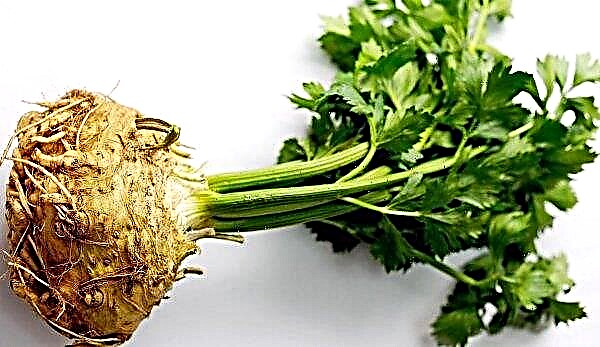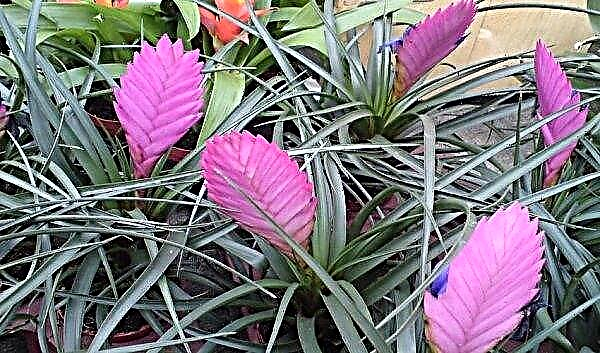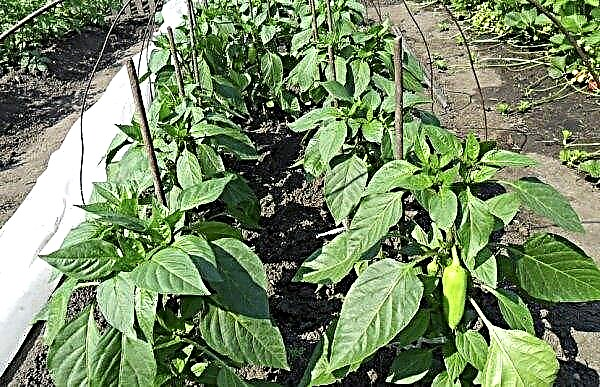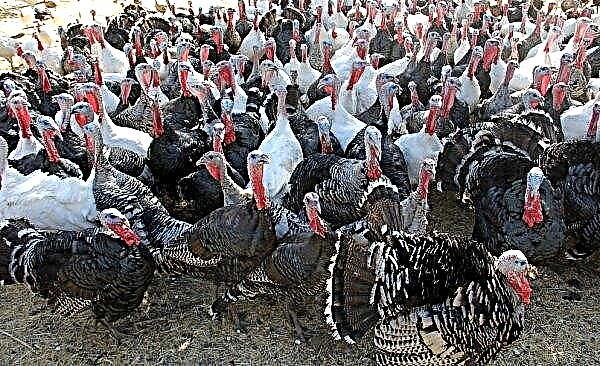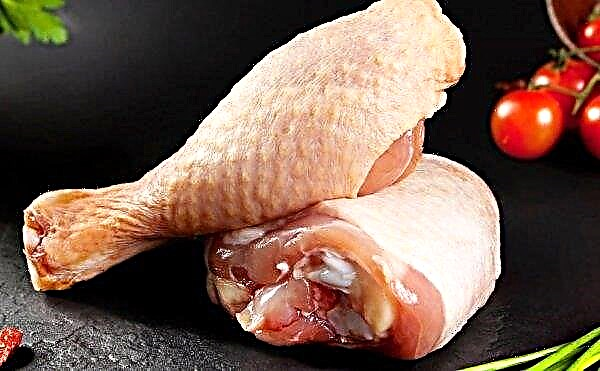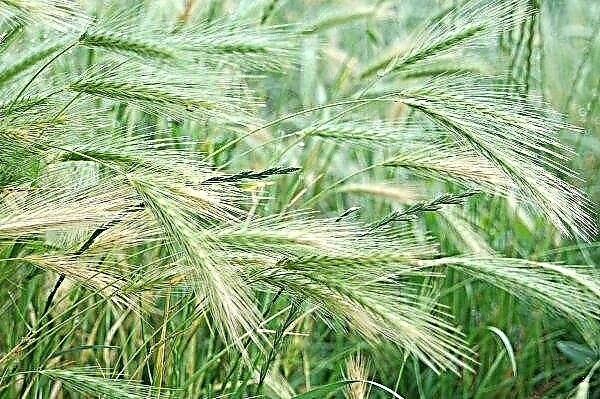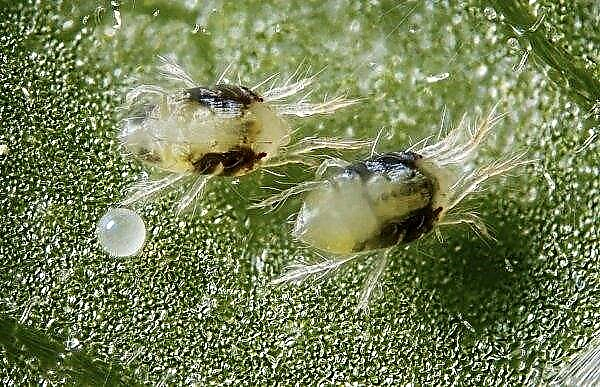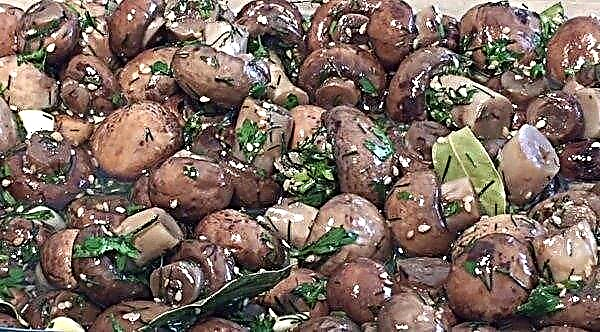One of the most delicious, juicy and high-yielding varieties of cabbage is the Westry hybrid, which has good winter hardiness and strong immunity. However, as many experienced vegetable growers claim, the culture is rather capricious and demanding in leaving. What are the features of the agricultural technology of cabbage, and how to properly grow it in open ground - further in the article.

Grade description
Vestry is a hybrid variety of cabbage of medium early maturity. Heads of cabbage reach technical maturity 85–100 days after planting seedlings.
This is a fairly powerful, strong plant, the head of which can grow up to 4-8 kg. Cabbage has large, slightly bubbled medium-sized leaves, collected in a large, raised rosette. The leaves have a pleasant green color and a smooth, waxy coating. Heads of culture are rounded flat, homogeneous, dense, with a short inner stump.
 It should be noted that the output of commodity products is more than 95%
It should be noted that the output of commodity products is more than 95%
The hybrid is characterized by high yields. For one season from 1 ha you can collect 500-750 centners of fruit. The maximum yield indicators were recorded in the Smolensk region and amounted to 870 c / 1 ha. Vestry fruits are universal, excellent for fresh consumption, as well as for the preparation of preservation, processing and preservation for the winter.
Specifications
Vestry is a hybrid, which was the result of many years of selection by employees of the Dutch agricultural company Monsanto. In 2006, the variety was included in the state register of fruit and vegetable crops of the Russian Federation, as a plant intended for cultivation in open ground in five regions of the state: Central, Ural, West Siberian, East Siberian and Volga-Vyatka. The described hybrid has an average ripening time and after transplanting the seedlings it is ready for harvesting in 80–95 days. Unlike other varieties, Vestry boasts versatility in use. Cabbage, due to the juiciness and crisp structure of the leaves, is ideal for salads, pickles or pickling. Also, the vegetable lends itself well to preservation for the winter. Providing optimal storage conditions, it is able to "lie" without changing the taste and aesthetic qualities for 3-4 months.
The described hybrid has an average ripening time and after transplanting the seedlings it is ready for harvesting in 80–95 days. Unlike other varieties, Vestry boasts versatility in use. Cabbage, due to the juiciness and crisp structure of the leaves, is ideal for salads, pickles or pickling. Also, the vegetable lends itself well to preservation for the winter. Providing optimal storage conditions, it is able to "lie" without changing the taste and aesthetic qualities for 3-4 months.
- Vegetable growers who are engaged in the cultivation of cabbage of the described variety, note a number of its key advantages:
- large-fruited;
- excellent taste and aesthetic qualities of heads of cabbage;
- resistance to many ailments, in particular, fusarium wilting;
- universal purpose of the fruit;
- uniformity in shape and size of heads of cabbage;
- high yields.
- The culture also has some disadvantages:
- poorly cultivated in closed ground;
- Demanding for loosening the soil and regular watering.
How to grow seedlings
Experts recommend growing a Westry hybrid using the seedling method, since the seed method is less effective.

Seed planting time
The hybrid belongs to the category of plants with an average ripening period, therefore, it is necessary to plant seedlings and, accordingly, to sow seeds, as early as possible. The optimal time for sowing seed material is considered to be the period from mid-March to mid-April.
Did you know? Some scientists claim that the Westry hybrid is descended from wild cabbage varieties native to Western Europe and America. At the same time, for the first time he was seen in the territory of Ancient Spain, where the locals called cabbage “ashchi”. In subsequent years, the vegetable came to Ancient Greece, Egypt and Rome.
Soil mix
Cabbage Vestry prefers light, nutritious and breathable soil mixture, which includes: one part of sod land and humus, wood ash, at the rate of 10 tbsp. l for every 10 kg of soil.
The soil mixture prepared in an apartment must be decontaminated using one of the available methods:
- freeze the soil for a day in the freezer;
- calcine the earth in the oven at a temperature of + 180 ° C for half an hour;
- spill the soil with a not very concentrated solution of potassium permanganate.
 For sowing grains, you can use a store soil mixture, while there is no need to disinfect it
For sowing grains, you can use a store soil mixture, while there is no need to disinfect it
For growing seedlings, it is recommended to immediately prepare individual peat pots or disposable plastic cups where seeds will be laid. The fact is that cabbage negatively relates to diving, and planting in separate containers will make it possible to avoid the procedure and plant seedlings immediately in the ground.
Seed preparation
Seed material must be carefully prepared before sowing. For this, it:
- Calibrate. Dip the seeds in a glass with salt solution for 20-30 minutes. Grains that have sunk to the bottom of the tank - used for sowing, which have surfaced to the surface - are thrown out due to their unsuitability.
- Disinfect. The material is wrapped in a small piece of cloth or gauze, dipped in warm water, at a temperature of + 45 ... + 50 ° С. After 20–25 minutes, the seeds are cooled with cold water for several minutes. This heat treatment allows you to destroy the causative agents of various diseases, as well as accelerate the process of germination of grains.
- Soaked in a solution of nitrophosphate. Seeds for 12 hours are sent to a solution of minerals, which will activate the germination of seeds.
- Temper. After some time, when the seeds swell, they are wrapped in gauze and sent to the refrigerator for one day, at night. In the daytime, the seed material is kept at room temperature, at night it is again sent to the refrigerator. After a few days of such hardening, grains can be sown in the ground.

Sowing seeds
Sowing seeds for seedlings is carried out in several stages:
- in prepared containers the soil mixture is poured, 8-10 cm high;
- in the soil, make indentations of 0.5-1 cm, into which 2-3 seeds are lowered;
- seed material is covered with soil, the surface is moistened with a spray.
 In order for the seeds to sprout faster, the container is covered with a plastic film to create a greenhouse effect and placed in a warm place with stable temperature indicators + 18 ... + 22 ° С.
In order for the seeds to sprout faster, the container is covered with a plastic film to create a greenhouse effect and placed in a warm place with stable temperature indicators + 18 ... + 22 ° С.Crop Care
5-7 days after sowing the seed, the first shoots should appear. At this time, the plastic shelter is removed, and the container with the sprouts is transferred to a cooler place, with a temperature of + 15 ... + 18 ° C.
In order for seedlings to grow and develop fully, it is necessary to organize a 12-14-hour light day, regular moistening with constant maintenance of the soil in a wet state.
Important! It is very important to maintain a balance of soil moisture: the soil should be moderately moist, but by no means moist.
If seedlings were grown in one container, then, when 5-6 fully developed leaves are formed on it, it is dived into separate pots. About 14 days before transplanting seedlings into open soil, they begin to harden it:
- a container with seedlings is taken out daily in the daytime to the street or balcony;
- in the first days, the seedlings are left in the air for 5-6 hours, gradually the duration is increased;
- after 7 days, containers with seedlings are no longer brought into the room and left on the street until the seedlings are planted in the ground.
Transplanting seedlings in the open ground
In late April - early May, when temperature readings stabilize, and the risk of recurrent night frost disappears, stronger and older seedlings are planted in open soil. The described hybrid is suitable for nutritious, loose and light soil with a neutral level of acidity. It is better to choose seedlings for planting seedlings, where cucumbers, potatoes, legumes or grain plants used to grow.
Despite the fact that cabbage tolerates partial shade and cold, it is recommended to plant it in a well-lit, sunny area, where there are no drafts and cold winds.
Seedling planting technology boils down to the following steps:Did you know? In the world there are about a hundred varieties of cabbage, however, all of them can be divided into three main groups: cabbage, leaf and color. The most common variety is considered white.
- the soil is loosened and moistened;
- recesses are made in the soil into which seedlings are planted from cups by the method of transshipment;
- planting is carried out according to the scheme 60 × 40 cm or 50 × 50 cm, while no more than 4 shoots are planted on 1 m²;
- plants are sprinkled with soil to the level of the first true leaf, the surface is well moistened;
- to prevent the formation of crust, the soil is sprinkled with a small layer of ordinary earth.
Care Tips
Vestry can be classified as capricious varieties, which for successful development require abundant, regular watering, as well as timely application of fertilizing.
Watering
The hybrid responds positively to abundant moisture and requires constant maintenance of a sufficient level of soil moisture. Immediately after transplanting seedlings, the frequency of irrigation measures is 2-3 times a week.
Important! Watering with cold water can provoke rotting of the root system.
 It should also be understood that the soil around the cabbage should be moderately moist, but not moist and marshy.
It should also be understood that the soil around the cabbage should be moderately moist, but not moist and marshy.
Soil care
Equally important for the development and fruiting of the culture is quality soil care. The soil around the bushes must be kept clean and regularly carried out:
- Loosening. When conducting an event for the first time, it is recommended to go deep by 4-5 cm, with further loosening, the soil can be dug up to a depth of 8-10 cm. Such procedures are performed systematically, ideally, before each moistening.
- Hilling. Hilling is considered a particularly important agricultural technique, which contributes to the formation of additional root processes. The procedure is carried out for the first time 20–25 days after transplanting, by “raking” the earth to the stem, to the height of the first full leaves. During the season, hybrid spud 2-3 times.
- Weeding. Destruction of weeds in the garden is one of the most important procedures for caring for cabbage. Parasitic plants take away nutrients from the culture and inhibit its development. Weeding is carried out systematically, while it is especially important to remove weeds before they bloom.
- Mulching. To avoid the growth of weeds, to preserve moisture in the soil and micro- and macrocells vital for the development of cabbage, mulching allows. During the event, the soil around the bushes is covered with a small layer of mulch - sawdust, hay or straw.




Top dressing
To achieve a high-quality crop, cabbage must be fed 3-4 times during the growing season:
- the first portion of fertilizers is applied 10 days after diving seedlings. In this case, a liquid mixture of: nitrate (2.5 g), superphosphate (4 g) and potassium chloride (1 g) is used;
- the second time the culture is fed already in the open ground, using a urea solution, 20 days after the sprouts are planted;
- the third and subsequent fertilizer application is carried out at approximately the same time interval using a solution of potassium monophosphate prepared at the rate of 10–20 g of the preparation per 1 bucket of water. On one plant, it is enough to pour 250 ml of the product.
Video: how to feed cabbage at home
After each loosening of the soil, experts advise dusting its surface with wood ash, which nourishes the plant well and, at the same time, prevents the development of fungal ailments.
Harvesting and storage
Heads of cabbage acquire technical maturity 85–95 days after transplanting, around late July – early August. To harvest, you need a sharpened, sanitized knife or shovel if you need to remove the cabbage along with the root roots.
The technology of harvesting Vestry fruits is quite simple:Did you know? Since the onset of technical maturity, all useful substances and vitamins in the head of cabbage are stored for 10 months.
- a head of cabbage is carefully cut with a knife, leaving the lower leaves and prolific peduncle at a height of 3-5 cm from the ground;
- cut heads of cabbage are stored in prepared containers or on a layer of straw. It is not recommended to put cabbage on moist soil;
- to increase the shelf life, the ripped fruit is left on the bed until the upper leaves are slightly attached.
If cabbage is dug along with the root, then the root system must be thoroughly cleaned of the remnants of the earth, yellowing and dried leaves are cut off from the head of cabbage. Heads of cabbage along with roots should be thoroughly dried in straw or hay.
 The collected fruits must be placed in wooden or plastic boxes, after wrapping each head with cling film. Specialists advise placing containers with vegetables in a cool, well-ventilated place, with temperature indicators of 0 ... + 3 ° C and a relative humidity of 80–90%. Under these conditions, heads of cabbage can be stored for 3-4 months.
The collected fruits must be placed in wooden or plastic boxes, after wrapping each head with cling film. Specialists advise placing containers with vegetables in a cool, well-ventilated place, with temperature indicators of 0 ... + 3 ° C and a relative humidity of 80–90%. Under these conditions, heads of cabbage can be stored for 3-4 months.
Mid-season Vestry hybrid is an ideal option for those who want to enjoy tasty, juicy, aromatic and extremely healthy cabbage in the autumn-winter time. The variety is distinguished by good yield and high quality of fruits, however, to achieve good results, the culture needs to provide decent, timely care, which consists in the competent organization of watering and feeding.


